
|
|
|
|
BY: SUN STAFF
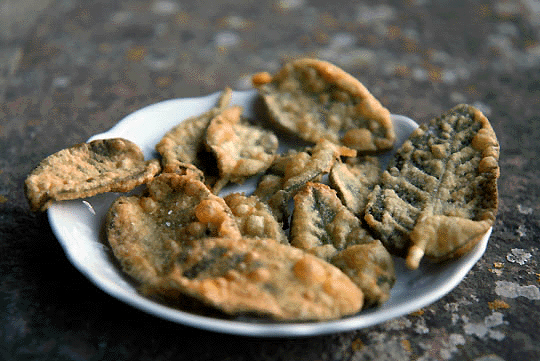
Fried Sage Jun 13, 2010 — CANADA (SUN) — A journey through India: border to border, bhoga to prasadam. Even in the west today, most fresh cooking leaves can be found in Indian and Asian groceries. Plucking a small handful of fresh lime or curry leaves into a pot of sabji is a most satisfying step in the preparation of dishes for Krsna. The cook knows, putting the lid back on the pot to trap the rising aroma, that these leaves will add a great layer of flavor to the dish.
Spicing leaves can be fried in butter, tempered in ghee, or roasted lightly to release their flavors, or they can just be submerged in a pot of cooking liquids or the roasting pan. Each cook has their own preference for removing the leaves before offering. Sometimes you'll wish to remove leaves at a mid-point in the cooking, so the flavor is perfectly balanced. Leaves that are very strong or acidic are best not left in a pot for hours, because they can eventually undo the delicate balance of flavors, more than help them. Some varieties of bay and lime leaves are in this category; both have a tendency to overpower, especially milk-based dishes.
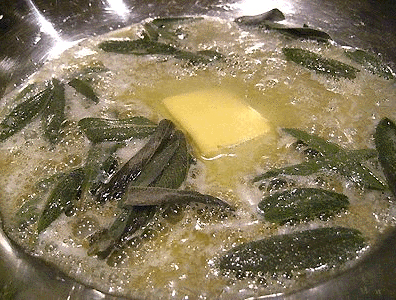
Butter-fried leaves Fried Leaves Some fresh leaves that are fried in ghee, like curry leaves, are perfect for leaving in the pot until serving, because they add a nice contrast of color, shape and texture to the dish. Curry leaves are thin enough that eventually, they'll cook down as soft as vegetable greens or if fried, will add a tender crispiness to the dish. Bay leaves are best removed before serving because they're too tough to eat and can even hurt one's tongue or mouth if taken accidentally. Curry leaves are available fresh or dried. These almond shaped, dark green leaves are very aromatic. They're used fresh in preparations to flavor vegetables, lentils and breads, and are used whole or ground in chaunks (fried spices). Like bay leaves, whole curry leaves can be added for their flavor, then removed from foods before serving. But again, they're also a good consistency to leave in, being eaten whole or crumbled. Some fresh leaves – particularly herbs like methi, parsley and sage – fry-up into delightful crispy treats to be mixed into sabjis and dals, or used as a garnish on top. These fresh leaves lend themselves well to being batter coated and fried, which adds an opulent touch to any prep. Whip up any batter like you would for pakoras or boondis, making it just thick enough to hold onto the surface of the leaf. Drop the coated leaves in hot ghee, frying until just golden and crisped, then remove and drain. Fried leaves can be prepared well ahead, and even stored in the fridge for later use. Another great way to use batter-fried edible leaves like sage, methi and parsley is to fry them, drain, then crumble them up into chenna balls, kofta, or even pakora batters. The tiny golden-green flecks add a lovely dimension, and increase the complexity of flavors. Spicing Leaves Many cooks create their own specialty masalas, and the gourmet chef will enjoy using leaves that s/he has hand-dried, if not grown. Bay trees are grown in many parts of the world, in warmer climates, and are a very nice tree to have in the kitchen garden. You have to choose the correct variety, however, as some Bay leaves are not to be used in cooking. The most common cooking Bay in the west is the Bay Laurel (Laurus nobilis, Lauraceae), grown through the Mediterranean and Asia. In the west, the California Bay tree (Umbellularia californica), also called the California Laurel or Oregon Myrtle, is similar to the Mediterranean cooking Bay, but has a stronger flavor. The Indian Bay is actually a completely different variety. Know as taj pat, tejpata, tamapatra, birinji ilai, or palav aaku, this bay leaf is from the Malabathrum (Cinnamomum tejpata) tree. It is similar in aroma and taste to Cinnamon bark or cassia, but milder. The tajpata leaf looks much like other bay leaves but behaves quite differently in cooked preparations. 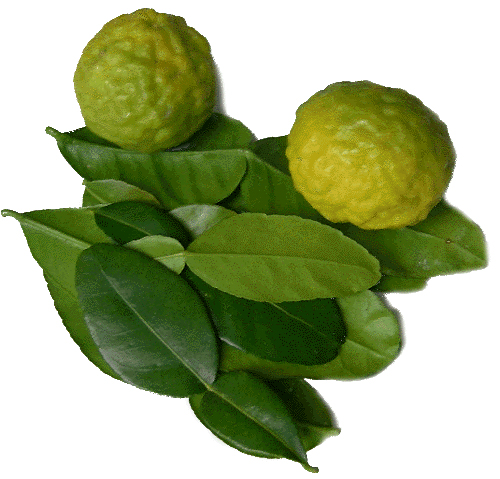
Kaffir Lime leaves Acidic Leaves There is one famous spice grind used in Vedic cooking, known as Katucaturjataka, which combines the leaves and bark of Laurus Cassia (Cinnamon Cassia) with other ingredients, including cardamom and black pepper. While we tend to think of them as aromatics, all four of these substances are considered acidic in Ayurveda, and therefore make a particular spicing masala. The more acidic leaves are excellent to use when preparing chutneys or jellies, because they act as a natural preservative and anti-bacterial. The Sanskrit term amlavarga refers to a class of plants with acid leaves or fruits, such as the lime, orange, pomegranate, tamarind, and sorrel. The leaves of Cicer (chickpea) are pleasantly acidic. Young chickpea leaves can be eaten as a cooked vegetable green, with good nutritional value. The younger leaves are higher in mineral content, therefore a little more acidic. In fact, their mineral content exceeds spinach and cabbage leaves. There is even a Sanskrit term describing the acid water drops that form on cicer leaves -- canakamlavar. Chickpea leaves used as an acid in chutneys will leave less of a flavor 'footprint' than lime leaves, for example, whose flavor can dominate milder fruits.
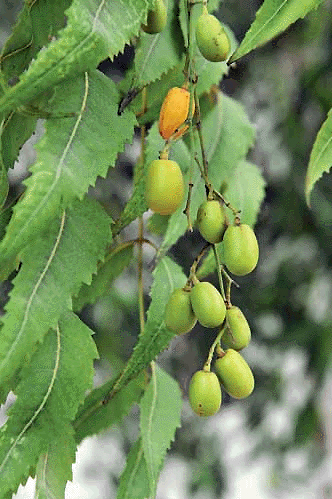
Neem leaves and fruits Medicinal Leaves Some leaves are most commonly used for medicinal purposes, but are also incorporated into Vedic food preparations. These include Neem (Nimba), Bael (Bilva), and Indian Ginseng leaves. The Bael is a medium-sized deciduous tree with thorny branches and trifoliate leaves. Besides being a favorite offering to Lord Shiva, bael is known for its medicinal qualities. Shiva worshippers end their day-long fasts by eating bael leaves at night. The Skanda Purana says that various incarnations of Parvati reside in each part of the Bael tree. Eating bael leaves alleviates diseases caused by excess vata and kapha (mucus), and there are many Ayurvedic remedies that use bael leaves. Fresh juice extracted from the leaves is mixed with black pepper to treat jaundice, and when diluted with water or honey, is a remedy for fever. The leaves and roots of Indian Ginseng (Ashwagandha) are used medicinally and in various foodstuffs. The leaves are steeped and the liquids used in recipe bases to add great vitality and vigor to sabjis, stews and dahls. A member of the hot pepper family (Solanaceae), gingseng leaves are used in Ayurveda for balancing the nervous system. Neem is one of the most highly prized of all leaves for its medicinal qualities. In fact, neem bark, leaves, twigs, seeds and sap are widely used. While neem is not used as commonly today as a cooking ingredient, it was favored in Bengal during Lord Caitanya's lila. In Caitanya-caritamrta Madhya and Antya lilas, we read about nimba leaves being used in sukhta soup and mixed with eggplant. It was a common brahminical practice to combine foodstuffs with high medicinal value into everyday cooked preparations, taking the opportunity to enhance one's health -- a very commonsense approach.
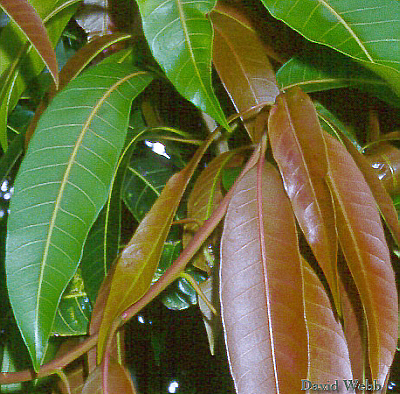
Mango leaves Mango leaves are another of the leaves known more for medicinal than flavoring properties, but they are also combined with cooked dishes on occasion. Although mango leaves are toxic if taken in excess, e.g. by cattle, a decoction of mango is a good medicinal and like Indian Ginseng, the steeped liquid can be put into other foodstuffs. Mango leaves help normalize insulin levels, and are good for diabetics. You can boil a few mango leaves in water and let it steep overnight, using the filtered liquid in other preps. 10 fresh, soft mango leaves can be ground to a paste with a few black peppercorns and a little water, and taken for upset stomach, diarrhea or vomiting. The yellowed leaves of mango can be steeped with a little cardamom overnight, then the water boiled and reduced by half. Mix this with a little milk and sugar to make a tea that is stimulating and energizing.
| |